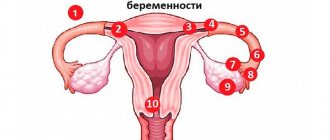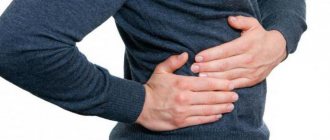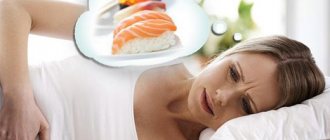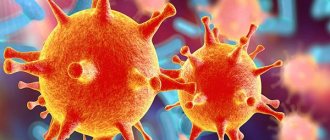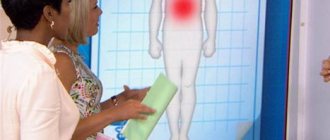Any pain syndromes cannot be ignored. Pain is the body’s physiological reaction to pathological processes; it causes changes in the patient’s behavior. At the level of instincts, movements are limited, which can cause even greater harm and aggravate the course of the disease. The central nervous system is responsible for taking conscious actions—seeing a doctor, a set of self-treatment measures.
Back hurts and nausea
Why does your back hurt most often?
Even ancient doctors argued that the spine is not only a set of vertebrae, but also the main frame of the body, and human health largely depends on its condition. A large number of nerve endings of both the central and peripheral nervous systems are concentrated here. Most internal organs are connected to the spine by nerve fibers, and pathological processes in them affect its condition.
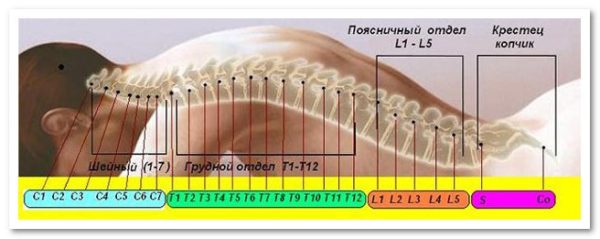
Structure of the human spine
The combination of pain with nausea is evidence of very serious problems; a decision should be made as soon as possible . The faster osteopathogenic diseases are differentiated from problems with internal organs, the lower the risk of negative consequences, and the treatment will take place faster and with less financial losses. Sometimes pain in the lower back is not associated with vertebral problems at all; pain syndromes radiate to this area from the internal organs. Let's look at two types of lower back pain with nausea - those that depend on the condition of the spine and those that are not related to its problems.
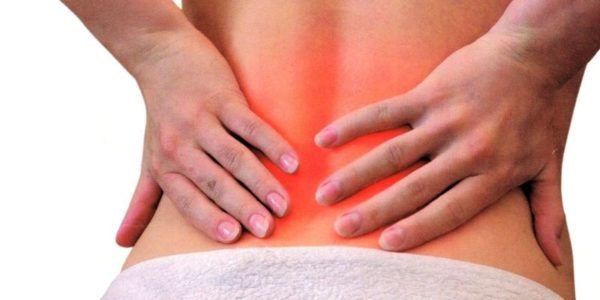
Lower back pain
Drug treatment
We list the main painkillers for back pain that are included in the course of proper conservative treatment.
Non-narcotic analgesics
These painkillers relieve pain symptoms due to any reason. With a short course of therapy there are practically no side effects.
- Baralgin M – from 305 rub.
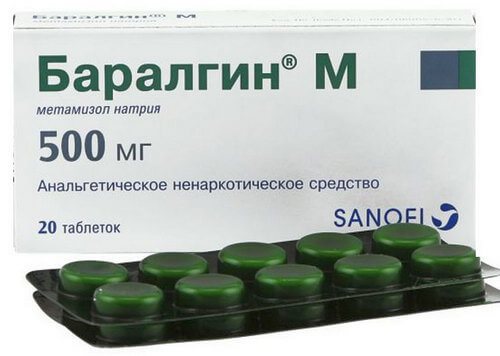
Baralgin M is an effective analgesic for back pain - Analgin – from 22 rub.
- Solpadein Fast – from 165 rub.
Nonsteroidal anti-inflammatory drugs (NSAIDs)
Such drugs are prescribed most often. They suppress the inflammatory process and reduce pain. They can cause a number of side effects, such as stomach pain.
- Diclofenac (Voltaren, Diclovit, Ortofen, Diclak). Inexpensive and effective drug. Price from 20 rub.
- Nise (Nimesil, Nimesulide). A good drug, causes few side effects. Costs from 220 rub.
- Arcoxia – from 405 rub.
- Meloxicam (Artrosan, Movalis) – from 80 rub.

Movalis is a safe NSAID that is well tolerated by many patients - Ketorolac (Ketanov, Ketorol) – from 50 rub.
- Lornoxicam – from 205 rub.
- Ketonal (Flamax, Bystrumcaps) – from 105 rub.
- Celebrex (Celecoxib) – from 210 rub.
Muscle relaxants
This type of medication aims to relax the back muscles. They are combined with other treatments to increase effectiveness. For example, with NSAIDs. Only a doctor should prescribe muscle relaxants.
- Tizalud – from 185 rub.
- Tizanidine – from 155 rub.
- Baklosan – from 320 rub.
- Mydocalm - from 410 rub.
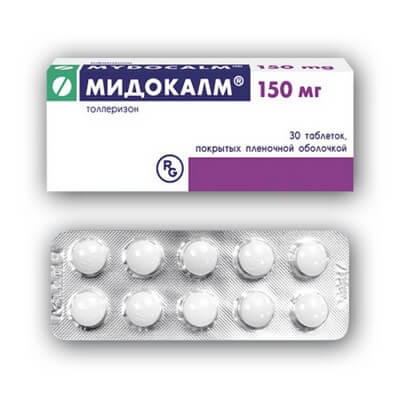
Mydocalm combines well with NSAIDs - Sirdalud – from 260 rub.
Narcotic analgesics
If NSAIDs do not help, and the pain is very severe, then narcotic painkillers may be prescribed. They block pain signals from reaching the brain. They are sold by prescription only.
- Tramadol;
- Vicodin;
- Morphine;
- Fentanyl.
Hormonal glucocorticosteroids
These medications contain the hormone cortisol. Hormonal drugs are prescribed if NSAIDs and muscle relaxants do not help. They are allowed to be used no more than once a year - the side effects can be very serious.
- Cortisone – from 910 rub.
- Methylprednisolone – from 210 rub.
- Kenalog – from 360 rub.
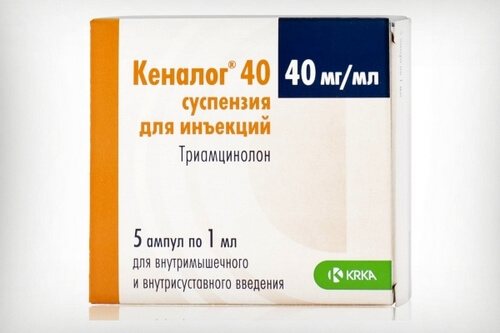
Kenalog helps when NSAIDs are ineffective - Dexamethasone – from 60 rub.
- Diprospan - from 230 rub.
Be sure to read this good article:
TOP 100 drugs for pain in the back, lower back and joints: painkillers, injections, suppositories, ointments, patches
B vitamins
It has been proven that these medications relieve pain, normalize the nervous system, and improve the condition of nerve endings.
- Milgamma – from 320 rub.
- Trigamma – from 190 rub.
- Combilipen - from 180 rub.
Chondroprotectors
When chondroprotectors are used for 3 months or more, damaged cartilage tissue in the intervertebral discs and joints is restored.
- Artradol - from 850 rubles;
- Don - from 1350 rub.;
- Mukosat - from 660 rubles;
- Alflutop – from 1700 rub.
Novocaine blockades
These are injections into painful (trigger) points, or between the vertebrae (epidural block). They are placed only in cases of very severe pain that cannot be relieved with NSAIDs and analgesics.
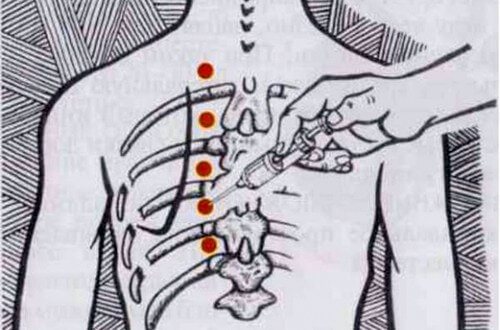
Novocaine blockades are placed urgently, in case of very severe pain.
The blockades take effect very quickly. The composition includes Novocaine and a corticosteroid (Diprospan, Prednisolone). The procedure must be performed by an experienced doctor.
Candles
This type of treatment is prescribed to those patients for whom tablets and injections are contraindicated. Rectal suppositories are inserted directly into the anus before bed. The course of therapy is 5 days.
- Voltaren - from 310 rubles;
- Ketonal - from 270 rubles;
- Diclovit - from 175 rubles;
- OKI - from 295 rubles;
- Diclofenac – from 55 rub.
Great article on the topic:
TOP 50+ best pain-relieving suppositories for pain in the back, lower back and joints
Ointments
Simultaneously with the use of tablets and injections, you can use local remedies: ointments, gels and creams.
The ointment can be used up to 3 times a day for 1-2 weeks.
Pain relieving ointments:
- Nise – from 280 rub.;
- Ketoprofen – from 105 rubles;
- Fastum gel – from 285 RUR;
- Dolgit – from 110 rubles;
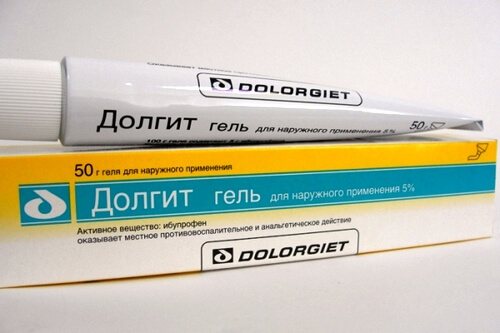
Dolgit provides analgesic and anti-inflammatory effects - Voltaren emulgel – from 235 rubles;
- Dolobene – from 480 rubles;
- Viprosal B – from 385 rub.
Plasters
This is a very convenient form of local remedies. The product is a plate with a medicinal substance applied on one side. The patch should be applied to the painful area and kept for the specified period.
The most effective pain patches:
- Voltaren – contains diclofenac sodium, is effective for at least 24 hours. Price – from 275 rub.
- Versatis contains lidocaine and lasts up to 12 hours. Costs from 910 rub.
If you suspect any pathologies, you should consult a doctor for pain and vomiting
As mentioned above, no pain syndromes should be ignored; these are special signals sent by the body to the nervous system for the purpose of self-preservation.
Table. What suspicions should be clarified in medical institutions?
| Suspicion of illness | Brief description and algorithm of action |
| Osteochondrosis | It is a very complex disease; currently there are no medical protocols for effective treatment; medicine can only slow down the progression of the disease and improve the patient’s standard of living. If, in addition to back pain and nausea, you feel dizzy, then this is a sure sign of the development of severe osteochondrosis. Often office workers attribute the described symptoms to a sedentary lifestyle, but the cause can be much more dangerous. Vomiting occurs after the degradation process has gone very far; deformed bone tissue compresses the blood vessels supplying the brain. Lack of oxygen in some parts of the brain causes nausea due to back pain. If symptoms intensify during movements of the spine, vomiting syndromes become extremely strong when coughing, headaches, spatial orientation are lost, then it is necessary to visit a medical facility as quickly as possible. |
| Heart problems | Nausea is accompanied by pain in the spine, radiating to the chest - a strong suspicion of heart problems. When diagnosing heart patients, doctors note that in such conditions, a lying patient may feel very strong urges to vomit, especially when lying down. If symptoms in a state of complete rest do not go away within 10–15 minutes, then you should consult a doctor. Back pain is not primary, but secondary signs of heart problems, but they play an important role during the accurate diagnosis of pathologies. |
| Meningitis | A very dangerous infectious disease that can be fatal. Only an experienced doctor can make a correct diagnosis without laboratory data, and such tests may not be performed in every hospital. Patients often complain of back pain and nausea, the problem is that such secondary symptoms are also inherent in other diseases. You need to be wary if the pain intensifies when you try to move your head, there is increased sensitivity to bright light and your body temperature rises sharply. Vomiting may occur due to swelling of the mucous membranes of the throat. |
| Consequences of injuries, including after accidents | This does not mean minor injuries to the spinal region due to heavy lifting or sudden bending. At the same time, back pain and nausea may appear after serious accidents or other emergencies. In these cases, both the vertebrae and intervertebral discs, as well as internal organs, are injured. Injured vertebrae pinch nerve fibers or endings and generate pain signals, and injuries to internal organs cause vomiting. The sooner a patient sees a doctor, the lower the risk of extremely negative health consequences. |
| Gastrointestinal diseases | An accurate diagnosis can be made by a gastroenterologist only on the basis of a complete examination of the patient. Such signs may include colitis, inflammation of the pancreas, stomach ulcer and other pathologies. The problem is that the secondary symptoms are very similar, but the diseases are different and require an individual approach in each specific case. Mistakes have negative consequences, delay treatment of the disease and increase the likelihood of dangerous complications. |
| Kidney pathology | Back pain appears after physical activity or as a result of poor diet, and intensifies during movement. Nausea is not always present; most often it occurs due to the movement of stones in the kidneys and urinary ducts. If such symptoms appear, an ultrasound scan is required. |
Why do women often experience lower back pain and nausea?
Lower back pain in women occurs due to the fact that the nerve endings of many anatomical organs are located there, the pathology of which can cause pain.
In various diseases, it is characterized by specific characteristics: duration, severity, provoking factors.
Knowledge of these signs allows you to make a differential diagnosis, establish the cause of pain and prescribe adequate treatment.
Lower back pain and nausea: causes
Whatever the nature of the pain in the lower back, if at the same time you feel sick or have a fever, this means that there is an inflammatory process in the body.
This condition cannot be corrected on your own: put the pills aside and make an appointment with a specialist.
However, you can determine which pathology has manifested itself in your case even before visiting a therapist
,
gynecologist
,
urologist
or a nephrologist. Depending on how much the lower back hurts, whether there is nausea, whether the attacks stop and whether there are additional symptoms in the form of fever, digestive disorders, dizziness and fainting conditions, you can find out more specific reasons that provoked the current condition.
The main causes are inflammatory processes
Of course, they will immediately cause pain in the lower back during menstruation, and it is not a fact that with the end of the critical days the unpleasant symptoms will subside. But to make a correct diagnosis, the doctor will have to conduct a series of examinations.
The fact is that this general name hides a number of diseases. This may be adnexitis, that is, inflammation of the ovaries and fallopian tubes. A characteristic symptom is not only pain in the lower back, but also a pulling sensation in the lower abdomen.
Treatment must be started as early as possible, since delay can lead to the most serious consequences. In this case, the first sign may be lower back pain during menstruation. The reasons for this are clear; pathogens can develop much more actively during menstrual periods.
It is not difficult to distinguish inflammation of the ovaries from normal menstruation; the pain will not go away after it ends and will only increase.
The solution to this problem can only be a serious course of treatment using antibiotics and antimicrobial agents. Do not forget that you cannot prescribe such strong drugs yourself, otherwise you can greatly harm your body.
Diseases and pathologies of the gastrointestinal tract
The combination of symptoms such as severe pain in the lumbar region, high fever, nausea and vomiting often signals the presence of pathological conditions of the gastrointestinal tract.
Intestinal infections
This broad group of diseases affects any person, regardless of gender, age, or social class.
This includes such terrible and potentially fatal diseases as dysentery, cholera, intestinal tuberculosis, and typhoid fever.
They can be recognized by the presence of fever and/or chills, mucus or pus in the stool, a general feeling of weakness, nausea, and also if the lower abdomen hurts.
Inflammation of the appendix
If you feel nauseous and have back pain in the lumbar region, along with a rise in temperature and an upset bowel movement, then the problem probably lies in inflammation of the vermiform appendix of the large intestine - the appendix. The problem can be solved exclusively through surgery; moreover, the sooner medical assistance is provided, the better. Otherwise, the appendix may rupture and cause peritonitis.
Colitis
The term “colitis” refers to inflammation of the wall of the large intestine that occurs as a result of infection entering the body. The disease affects both sexes, but in women it is most often diagnosed between the ages of 20 and 60 years, while for men the potentially dangerous period begins at 30–40 years.
Inguinal hernia
It is most often diagnosed in children, but can also occur in adults. A hernia is a protrusion of the intestines and pelvic organs through the anterior abdominal wall. Very often, patients mistake the disease for cancer, but there is no need to worry ahead of time, especially if there are no symptoms associated with cancer. But you need to visit a doctor.
Tumors
They are divided into benign and malignant.
If we talk about cancer of the gastrointestinal tract, then in addition to lumbar pain, nausea or vomiting, you may be plagued by sudden weight loss not associated with changes in diet or stress, weakness (a consequence of a decrease in the level of hemoglobin in the blood), the presence of blood streaks during bowel movements, fever, which lasts steadily for several weeks.
What diseases cause symptoms?
Symptoms may be caused by:
- diseases of the urinary system - urethritis, cystitis, prostatitis;
- sexually transmitted diseases – gonorrhea, chlamydia, trichomoniasis;
- fungal sexual infection - candidiasis;
- kidney diseases – pyelonephritis, urolithiasis, renal failure;
- liver diseases – hepatosis, hepatitis, cirrhosis, fibrosis;
- appendicitis - inflammation of the appendix of the rectum;
- intestinal diseases - colitis, duodenal ulcer, dysbacteriosis;
- gastric pathologies – gastritis, ulcers;
- pancreatic disease - pancreatitis;
- gynecological diseases in women - colpitis, uterine fibroids, adnexitis, endometriosis;
- cysts and malignant formations of the genital organs and abdominal cavity.
In diseases of the musculoskeletal system: scoliosis, vertebral protrusions, lumbar radiculitis, osteoporosis, scoliosis, severe back pain occurs, innervation of which can occur in the internal organs, arms and legs. But nausea rarely occurs.
And vice versa - problems of internal organs often manifest themselves as pain radiating to the back: for example, kidney pathology is “masked” as lumbar osteochondrosis.
Diseases of the urinary system
The second group of diseases, in which a person has lower back pain, nausea and dizziness, is associated with the kidneys, bladder and other organs of the genitourinary system. As a rule, in this case, the unpleasant symptoms are also accompanied by pain when urinating.
Back pain and nausea are not associated with spinal pathologies
These are the so-called secondary pain sensations; the problematic organs are located far from the spine, but are connected to it by the nerve endings of the peripheral system.
Gastrointestinal tract
Unpleasant sensations due to problems with these organs have their own characteristics. As a rule, pain is only on one side of the spine, spreads to the lower back, can rise to the cervical region, and radiate to the collarbone or scapula. Another sign is not only the urge to vomit, but also quite severe vomiting with bile, and the temperature may rise.
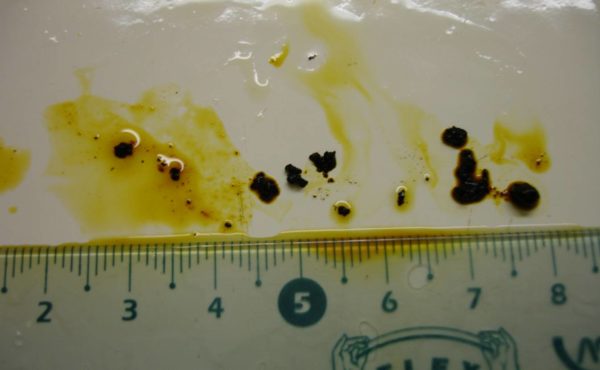
Vomiting bile
Such signs are common to several diseases.
- Stomach ulcer . The pain is sharp and begins immediately after eating. The back may feel aching or shooting. In the stomach without food, acidity increases, the patient feels heartburn. After vomiting, you feel a little better.
- Perforated ulcer. Unpleasant sensations appear suddenly and for no apparent reason, the pain is sharp, simultaneously in the stomach and lower back. The abdominal wall is tense, muscle spasm is observed. Depending on the characteristics of the disease, pain may additionally be localized above the navel or in the right side of the abdominal cavity.
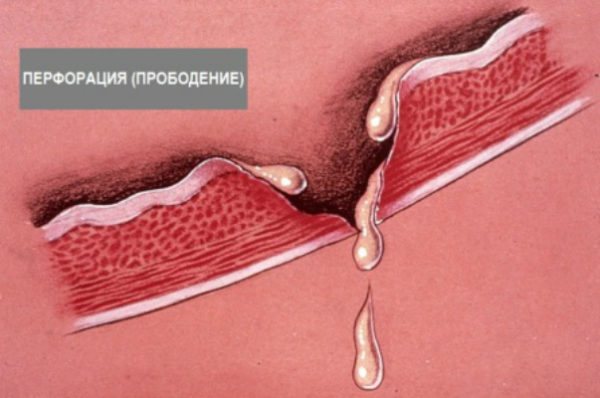
Perforated stomach ulcer
- Pathologies of the pancreas . May be chronic or acute. The pain is very strong and surrounds the lower back. Vomiting may occur, but there is no relief after it. The pulse is frequent, there is shortness of breath, sweating, pallor, and the pulse quickens.
- Hepatic colic . The pain begins under the rib, over time it moves between the shoulder blades and into the lower back, the big one turns pale and sweats, a jaundiced tint of the skin and eyes appears. After a short time, the stomach becomes tense and bloated, nausea and the urge to vomit appear. Urine is dark, feces are black. This is a very dangerous disease with a high percentage of deaths. Seeing a doctor is mandatory; further treatment is only inpatient under constant supervision.
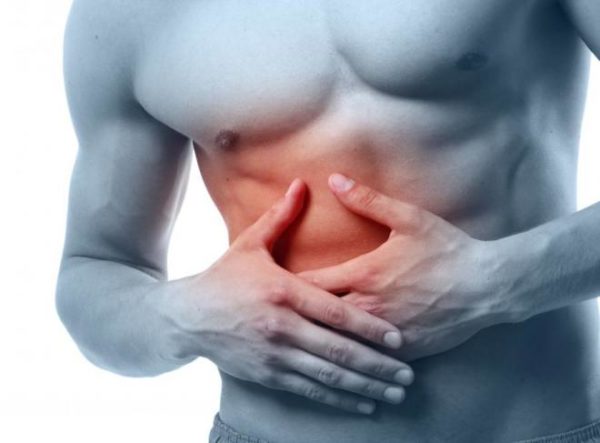
Hepatic colic
Table: additional symptoms and causes
| Add. symptom | Cause |
| Back hurts, dizzy | Osteochondrosis, ankylosing spondylitis, vertebral displacement, myofascial syndrome, pregnancy, premenstrual syndrome, prostatitis, renal colic, myeloma |
| Neck hurts | Cervical osteochondrosis, cervical spondylosis, trauma, disc protrusion (hernia), meningitis (inflammation of the meninges), myositis (inflammation of the muscles), neuralgia |
| Lower abdomen hurts | Enteritis, menstruation, pregnancy, prostatitis, radiculitis |
| I have a stomachache | Appendicitis, gastritis, gastric ulcer, pancreatitis, cholecystitis |
| Dizziness | Meniere's disease, stroke, fasting, hypertensive crisis |
| Headache (pain in the head) | Fatigue, lack of sleep, stress, stroke, hypertension |
| My stomach hurts | Gastritis, poisoning, food intolerance, ulcer, erosion |
| Chest hurts | Cardiac ischemia, thoracic radiculitis, bruise, neuralgia |
| Weakness | Diabetes mellitus, anemia, tuberculosis, HIV, influenza, fatigue |
| Back muscles hurt | Physical activity, bruise, spondyloarthrosis, disc herniation |
| Be sick | Infection, poisoning, pregnancy, intestinal diseases |
Pain in the back and pelvis, accompanied by nausea
Such symptoms indicate inflammatory processes in the pelvic area. It is recommended to monitor pregnant women especially carefully; the described clinic may indicate pathologies during pregnancy. In men, discomfort in the pelvic area indicates problems with the prostate. If the pain is accompanied by fever, vomiting, and unusual discharge, then this indicates the seriousness of the pathological processes and requires immediate attention to medical institutions. Cystitis, ovarian cysts, gonorrhea, prostatitis, mycoplasmosis and other diseases of the pelvic organs have the same secondary symptoms.
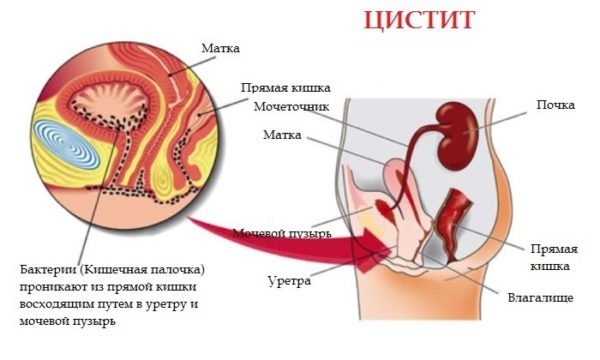
In most cases, cystitis affects women, the reason is the anatomical features of the structure of the urinary system
Development and treatment of osteochondrosis
The disease occurs due to pathological processes in the tissues of the intervertebral discs. Dystrophic changes occur in the structures that provide strength and flexibility to the spine. Head pain, tinnitus and nausea are characteristic of cervical osteochondrosis. Damage to the thoracic vertebrae is manifested by difficulty breathing, heart pain, and in the lumbar region - disturbances in the functioning of the intestines and kidneys.
Lumbar osteochondrosis
My back hurts and my lower back is strained, not only due to osteochondrosis. Another common cause is muscle strain. Therefore, it is necessary to distinguish these pathologies. Symptoms of lumbar osteochondrosis may be as follows:
- “lumbago” in the back;
- muscle tension;
- headaches and abdominal pain;
- if the lumbar spine is affected, acute pain occurs in the lower back;
- dizziness;
- depression;
- insomnia.
Traditional therapy
Medications are required to eliminate pain and protect the vertebrae from further degradation. Not one method or drug is used, but a complex: medications, physiotherapeutic procedures, therapeutic exercises.
You should adhere to a gentle diet. Eating salty and sour foods, fatty meats, and marinades disrupts the acid-base balance, which causes more pain in the lower back or the entire spine.
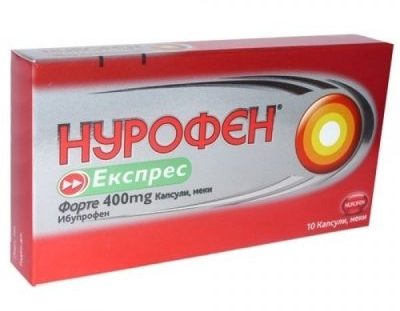
Treatment of pain and dizziness with osteochondrosis includes:
- Painkillers (Nurofen, Ketonal).
- Muscle relaxants (Mydocalm).
- Anti-inflammatory drugs (Diclofenac, Movalis).
- Chondroprotectors (Chondroitin).
- Massage.
- Acupuncture.
- Physiotherapy (therapeutic mud, herbal baths).
Drugs from this group improve peripheral blood circulation, which helps cope with dizziness. Thanks to these properties, the patient can reduce the intake of NSAIDs and hormonal drugs.
The drug Mydocalm contains the active components tolperisone and lidocaine. It has analgesic, antispasmodic, and vasodilating effects. After taking the product, it quickly eliminates muscle tension, so the pain goes away. There are also side effects, including dizziness, nausea, and decreased blood pressure.
Conservative treatment of osteochondrosis of the lumbar spine includes balneotherapy - the use of healing mud and mineral spring water. They also affect the affected areas with electric and magnetic fields and ultraviolet radiation.
It is important that physiotherapy has few contraindications and can serve as an alternative to taking medications during pregnancy or in case of allergic reactions to drugs. Acupuncture, electrorelaxation, electrophoresis are also used
Alternative Medicine and General Advice
Diseases in the acute period are treated with medications, which quickly help if the lower abdomen is tight, lower back hurts and dizzy. The basis of therapy after eliminating pain is procedures that strengthen muscles and vascular walls. For this purpose, vascular drugs are used: Vinpocetine, Cavinton.
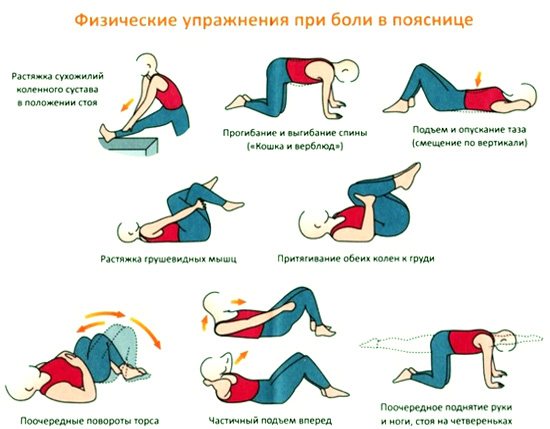
Exercise for low back pain
The relaxing effects of massage and aromatherapy are well known. These methods of alternative medicine help in combination with medications and folk remedies. Those who feel dizzy or have lower back tension should choose a back massage complex to improve muscle tone and normalize blood circulation. It is recommended to use tapping and stroking with measured movements.
Living and working at the limit of the body's capabilities leads to a natural result - diseases. Pain in the cervical and lumbar spine, dizziness, sleep and sexual life disorders appear. It is recommended at any age to protect your body from overload and avoid factors that negatively affect the functioning of organs and systems.
A healthy diet includes eating plenty of fruits and vegetables. Fried, salty, fatty and spicy foods are best avoided. It is necessary to spend more time outdoors, dedicate part of the time to hobbies, communication with family and friends. These simple recommendations will help prevent the appearance of negative symptoms and avoid a relapse of an existing pathology.
Therapy and prevention
Treatment in most cases should be carried out under the supervision of a doctor, after the cause has been established. But before consulting a doctor, the patient can provide first aid to himself.
You need to rinse your stomach to get rid of toxins. Do not stop diarrhea with antidiarrheal tablets. You can take sorbents. It is recommended to drink large volumes of water in small sips.
Self-medication in this case is contraindicated. If the disease is accompanied by vomiting and diarrhea, you need to replenish the water-salt balance by taking Regidron. Eliminate fatty, spicy, difficult-to-digest foods from the menu. It is worth seeking medical help.
The patient must see a doctor and undergo the necessary tests. If the disease is confirmed, the doctor decides to hospitalize the patient in the infectious diseases department, where treatment will take place. Intestinal infections can be contagious and pose a health threat to the family of the sick person. That is why treatment takes place in a hospital.
Treatment of inflammatory bowel diseases
Processes that cause irritation of the gastrointestinal tract are called inflammatory bowel diseases (IBD). The most common cases of IBD are ulcerative colitis and Crohn's disease.
Symptoms of IBD manifest differently depending on the condition of the body. At the same time, they appear and disappear cyclically. According to statistics, the peak incidence occurs in the age range of 20-35 years.
IBD often causes recurrences of diarrhea and abdominal cramps. Some people also experience joint pain, which may be felt in the lower back.
Unfortunately, the exact cause of intestinal diseases has not been studied; it is completely impossible to cure.
sudden weight loss;
nausea and vomiting;
At the first symptoms of IBD, you should consult a doctor.
There is no cure for ulcerative colitis or Crohn's disease, so treatment usually involves a combination of medications and lifestyle and dietary changes. Surgery is required to treat complications of IBD.
As a preventive measure it is necessary:
avoid stress (they provoke relapse);
eat healthy foods with sufficient mineral supplements;
take probiotics to protect the intestinal lining;
play sports: hiking, swimming, yoga, Pilates;
give up alcohol and smoking.
